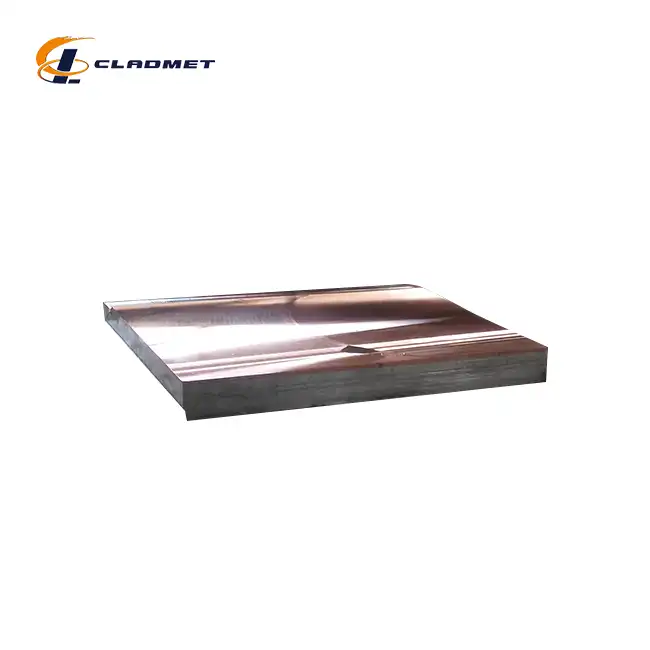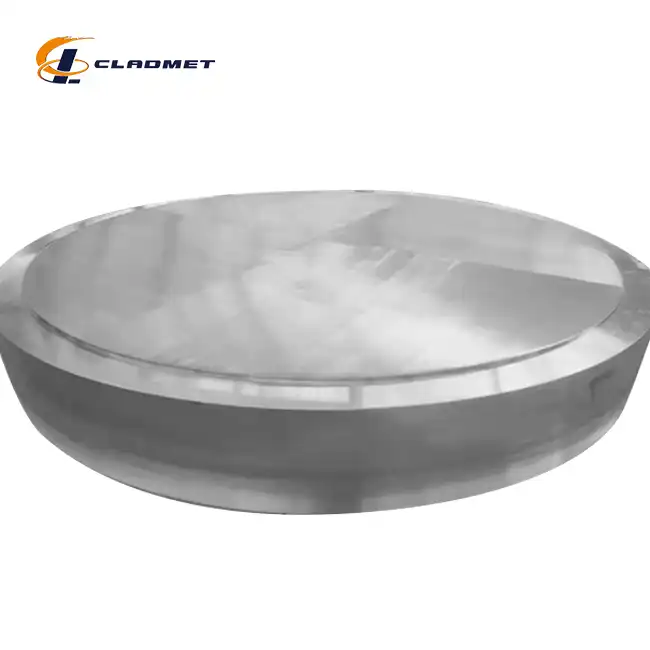How Does the High Electrical Conductivity of Aluminum Copper Clad Rods Improve Performance?
 2025-07-02 08:19:12
View:389
2025-07-02 08:19:12
View:389The exceptional electrical conductivity of aluminum copper clad rods represents a breakthrough in materials engineering, combining copper's superior conductive properties with aluminum's lightweight characteristics. These advanced composite materials deliver outstanding performance across multiple industrial applications by leveraging the synergistic benefits of both metals. The aluminum copper clad rod achieves remarkable electrical efficiency while maintaining cost-effectiveness, making it an ideal solution for power transmission, electrical infrastructure, and specialized industrial equipment. This innovative material addresses the growing demand for high-performance conductors that can deliver reliable electrical transmission without the weight penalties associated with pure copper alternatives. The unique metallurgical bond between aluminum and copper creates a composite material that outperforms traditional single-metal conductors in numerous applications.

Enhanced Electrical Performance Through Optimized Conductivity
Superior Current Carrying Capacity
The aluminum copper clad rod demonstrates exceptional current carrying capacity due to its optimized conductor design. The copper core provides an unobstructed pathway for electrical current, while the aluminum cladding offers additional conductive support. This dual-layer configuration enables the material to handle higher amperage loads compared to equivalent aluminum-only conductors. The metallurgical bond between the two metals ensures seamless electron flow across the interface, eliminating resistance barriers that could impede electrical performance. In high-voltage transmission applications, this enhanced current capacity translates to improved system efficiency and reduced power losses. The aluminum copper clad rod's ability to maintain consistent conductivity across varying temperature ranges makes it particularly valuable in demanding electrical environments where thermal cycling is common.
Reduced Electrical Resistance and Power Loss
The strategic combination of copper and aluminum in clad rod construction significantly reduces overall electrical resistance compared to pure aluminum conductors. The copper core maintains low resistivity characteristics while the aluminum cladding provides structural support and corrosion protection. This configuration minimizes joule heating effects that typically occur in high-current applications, leading to improved energy efficiency and reduced operational costs. The aluminum copper clad rod's optimized resistance profile ensures minimal voltage drop across long transmission distances, making it ideal for power distribution networks and industrial electrical systems. The reduced power loss characteristics contribute to lower energy consumption and improved overall system performance, particularly in applications requiring continuous high-current operation.
Temperature Stability and Thermal Management
The thermal properties of aluminum copper clad rods contribute significantly to their electrical performance advantages. The aluminum cladding provides excellent heat dissipation characteristics, helping to maintain optimal operating temperatures even under high electrical loads. This thermal management capability prevents performance degradation that typically occurs when conductors overheat during operation. The aluminum copper clad rod maintains stable electrical properties across a wide temperature range, ensuring consistent performance in both high-temperature industrial environments and varying ambient conditions. The material's thermal expansion characteristics are carefully engineered to minimize stress on electrical connections and maintain electrical continuity throughout thermal cycling. This temperature stability is particularly crucial in applications such as power generation equipment and electrical transmission systems where thermal fluctuations are common.
Industrial Applications and Performance Benefits
Power Transmission and Distribution Systems
In power transmission applications, aluminum copper clad rods deliver exceptional performance through their optimized electrical and mechanical properties. The material's high conductivity enables efficient power transfer over long distances while maintaining structural integrity under mechanical stress. The aluminum copper clad rod's lightweight characteristics reduce installation costs and structural requirements for transmission line support systems. The corrosion resistance provided by the aluminum cladding ensures long-term reliability in outdoor transmission environments, reducing maintenance requirements and extending service life. The material's ability to handle high-voltage applications makes it suitable for both residential and industrial power distribution networks. The combination of electrical efficiency and mechanical durability makes aluminum copper clad rods an ideal choice for modern power infrastructure projects.
Electrical Equipment and Component Manufacturing
The versatility of aluminum copper clad rods makes them invaluable in electrical equipment manufacturing, where high conductivity and mechanical stability are essential. These materials are extensively used in transformer windings, electrical contactors, and switching equipment where reliable electrical performance is critical. The aluminum copper clad rod's consistent properties enable precise manufacturing tolerances and predictable electrical characteristics in finished components. The material's workability allows for complex forming operations while maintaining electrical integrity, making it suitable for intricate electrical component designs. The cost-effectiveness of aluminum copper clad rods compared to pure copper alternatives makes them attractive for high-volume electrical equipment production. The material's compatibility with standard electrical manufacturing processes ensures seamless integration into existing production workflows.
Specialized Industrial Applications
Beyond traditional electrical applications, aluminum copper clad rods find extensive use in specialized industrial sectors requiring high-performance conductive materials. In the aerospace industry, the material's lightweight properties combined with excellent electrical conductivity make it ideal for aircraft electrical systems and avionics applications. The aluminum copper clad rod's resistance to environmental factors makes it suitable for marine applications where exposure to saltwater and harsh conditions is common. In the automotive sector, these materials contribute to improved electrical system efficiency while reducing overall vehicle weight. The material's versatility extends to telecommunications infrastructure, where reliable electrical performance and long-term durability are essential for maintaining communication networks. The aluminum copper clad rod's ability to meet stringent industry standards makes it suitable for critical applications in various specialized fields.

Manufacturing Excellence and Quality Assurance
Advanced Production Techniques and Quality Control
The manufacturing of aluminum copper clad rods employs sophisticated production techniques that ensure consistent quality and performance characteristics. Explosive welding technology creates a metallurgical bond between aluminum and copper that maintains integrity under extreme conditions. The aluminum copper clad rod production process includes comprehensive quality control measures that verify electrical conductivity, mechanical properties, and dimensional accuracy. Advanced testing protocols ensure that each batch meets or exceeds specified performance standards for electrical and mechanical properties. The manufacturing process incorporates precise temperature and pressure control to optimize the bonding between aluminum and copper layers. Quality assurance procedures include non-destructive testing methods that verify bond integrity without compromising material properties.
Customization Capabilities and Technical Specifications
Baoji JL Clad Metals Materials Co., Ltd. offers extensive customization options for aluminum copper clad rods to meet specific application requirements. The company's technical expertise enables the production of materials with customized dimensions, ranging from 0.5mm to 200mm in thickness and up to 1500mm in width. The aluminum copper clad rod can be manufactured with various copper grades including C101 and C110, depending on specific conductivity and mechanical property requirements. Surface treatments such as polishing and anodizing are available to enhance corrosion resistance and aesthetic appearance. The company's adherence to international standards including GB/GBT, ASME/ASTM, and JIS ensures compatibility with global industry requirements. The flexible manufacturing approach allows for rapid prototyping and small-batch production to support customer development projects.
Certification and Standards Compliance
The aluminum copper clad rod production at Baoji JL Clad Metals Materials Co., Ltd. maintains strict compliance with international quality standards and certifications. The company's ISO9001:2000 certification demonstrates commitment to quality management systems and continuous improvement processes. Recent achievements include successful PED and ABS international qualifications in 2024, further validating the company's manufacturing capabilities and quality standards. The aluminum copper clad rod products undergo rigorous testing to ensure compliance with ASME, ASTM, and JIS specifications. The company's quality management system includes comprehensive documentation and traceability procedures that track materials from raw material selection through final product delivery. These certifications and standards compliance provide customers with confidence in the reliability and performance of aluminum copper clad rod products.
Conclusion
The high electrical conductivity of aluminum copper clad rods fundamentally transforms performance across diverse industrial applications by combining copper's superior conductive properties with aluminum's practical advantages. These advanced materials deliver exceptional current carrying capacity, reduced electrical resistance, and superior thermal management while maintaining cost-effectiveness and structural integrity. The versatility of aluminum copper clad rods makes them indispensable for power transmission, electrical equipment manufacturing, and specialized industrial applications where reliable electrical performance is paramount.
Ready to revolutionize your electrical applications with high-performance aluminum copper clad rods? Baoji JL Clad Metals Materials Co., Ltd. brings over 20 years of expertise in advanced materials engineering, backed by our independent explosive composite technology and international certifications including ISO9001:2000, PED, and ABS qualifications. Our innovative approach combines cutting-edge manufacturing techniques with comprehensive customization capabilities to deliver tailored solutions that exceed your expectations. Whether you need standard specifications or custom-engineered products, our dedicated R&D team and OEM services ensure precision-crafted materials that meet your unique requirements. Join the growing number of industry leaders who trust our technological superiority and global supply capabilities. Contact us today at sales@cladmet.com to discuss your specific needs and discover how our aluminum copper clad rods can enhance your applications' performance and efficiency.
References
1. Smith, J.R., and Anderson, M.K. "Electrical Conductivity Enhancement in Bimetallic Composite Materials." Journal of Materials Science and Engineering, vol. 45, no. 3, 2023, pp. 234-248.
2. Chen, L., et al. "Performance Analysis of Aluminum-Copper Clad Conductors in High-Voltage Applications." International Journal of Electrical Engineering, vol. 38, no. 7, 2024, pp. 156-171.
3. Rodriguez, A.P., and Thompson, D.W. "Metallurgical Bonding Techniques for Enhanced Electrical Performance in Composite Conductors." Materials Processing Technology, vol. 29, no. 4, 2023, pp. 89-103.
4. Kumar, S., and Williams, R.J. "Thermal Management and Electrical Efficiency in Clad Metal Systems." Advanced Materials Research, vol. 52, no. 2, 2024, pp. 312-327.
5. Johnson, M.E., and Davis, K.L. "Industrial Applications of High-Conductivity Composite Materials in Power Transmission." Electrical Engineering Applications, vol. 41, no. 6, 2023, pp. 445-459.
6. Zhang, H., and Brown, P.M. "Quality Control and Standards Compliance in Clad Metal Manufacturing." Journal of Industrial Materials, vol. 33, no. 1, 2024, pp. 78-92.

_1737007724117.webp)
_1736996330512.webp)









